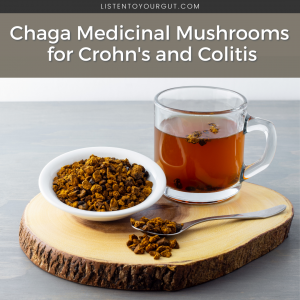How my Chaga journey began …
My interest in chaga really peaked when my doctor mentioned the benefits of ulcerative colitis during one of my office visits. He explained that new research has shown that chaga can help remission in patients with ulcerative colitis and cure other IBD conditions!
I take it daily now and am absolutely in love with it! The benefits are immense. Whether you have Crohn’s disease, colitis, or any other form of IBD, it is definitely worth taking a look.
It tastes good too!
As I did more research, one of the facts that struck me was that chaga was shown to lower inflammation in the GI tract – and that’s just ONE of its many benefits. But first what is chaga?
What is chaga?
Northern Europe, Siberia, Russia, Korea, Northern Canada, and Alaska all grow chaga (Inonotus obliquus), which is found primarily on the bark of birch trees. So chaga is a mushroom in case you are wondering!
What are some of the benefits of chaga?
- Very rich in antioxidants
- Lowers inflammation
- Supports immunity
- Prevents and fights cancer
- Lowers blood sugar
- Lowers blood pressure
And according to today’s medical news, here are a few more benefits for you!
Chaga mushrooms are rich in a wide variety of vitamins, minerals, and nutrients, including:
- B complex vitamins
- Vitamin D
- potassium
- Rubidium
- Cesium
- amino acids
- Fiber
- copper
- selenium
- zinc
- iron
- manganese
- magnesium
- calcium
No wonder they call this a superfood!
Chaga and IBD
As I did more research, I found the following information from the Integrative Health Institute very useful:
Inflammatory bowel disease (Crohn’s disease and ulcerative colitis)
Chaga mushroom extract may be beneficial in treating inflammatory bowel disease. Oxidative stress (free radical damage) on cells lining the gastrointestinal tract can contribute to the development of inflammatory bowel diseases such as Crohn’s disease and ulcerative colitis. Chaga mushroom extract suppresses edema (swelling) and damage to the mucous membranes in the intestine and has anti-inflammatory effects on areas in the colon and rectum.
How can you consume chaga?
 Personally, I use a powdered form of chaga and a mushroom mix in my breakfast smoothie every day. But what is so cool about chaga is that there are three different ways to consume it!
Personally, I use a powdered form of chaga and a mushroom mix in my breakfast smoothie every day. But what is so cool about chaga is that there are three different ways to consume it!
You can consume it through:
- Tea – Chaga pieces can be boiled in water for 15 to 30 minutes to make a tea you can drink. They can also be used as a base for soups or smoothies.
- You can also cook the chaga with other herbs or spices to create bespoke tea blends. It goes well with chai spices (cardamom, ginger, cloves, aniseed, fennel, etc.) or with cocoa, chickory and dandelion root.
- Tincture / Supplement – Some supplement companies have made really fantastic liquid chaga extracts and included chaga in their supplement formulations.
- Powder – Chaga mushroom powder is easy to add to soups, smoothies, and teas. It has an earthy, slightly vanilla-like taste.
The LTYG shop carries both Chaga powder and tincture. And if you’re a big fan of mushroom medicine, like me, we also have a medicinal mushroom tincture, as well as a 10-mushroom formula in capsule form.
Mountain Rose Herbs supplies our Shoppe Chaga Powder and there are a few key points to keep in mind when sourcing your Chaga:
“One of the things that make chaga so valuable is its indomitable nature. Like many other valuable mushroom varieties, Chaga only grows in the wild. Unrestricted and untrained wildcrafting practices can jeopardize the future of chaga and its wild habitat. Unskilled pickers often harvest whatever conks they find, regardless of size, and sometimes dig deep into the trees to extract as much fungus as possible. Such reckless harvesting practices are likely to kill the fungus, its host tree, or both.
In addition to environmental hazards, improper harvesting practices can also significantly affect the quality of the mushrooms they pass on to consumers. The timing of harvest is critical to getting the highest nutritional content in your chaga. However, unregulated harvesters often collect chaga indiscriminately throughout the year. In addition, chaga can be dried and processed without regulation or supervision with contaminants such as juice still intact, often under non-standardized temperature conditions that further increase the risk of mold and bacterial contamination.
Chaga contains the highest concentration of the antioxidant melanin during the coldest months of the year. Therefore, the Conks harvest maximizes its nutritional properties only in the middle of winter. Since chaga becomes more nutritious the longer it grows on a tree, only conks weighing six pounds or more are collected, while smaller conks are stored in a GPS device for future harvests. “
So … is chaga worth it?
In conclusion, I think it’s worth checking out chaga and other medicinal mushrooms for your gut or other health issues! Because they are just fantastic for the immune system.
I hope this information can help you, as I did on my healing journey. Let’s give it up for the mushrooms!
Have you tried medicinal mushrooms while curing IBD or other problems? Please comment below and let me know! 🙂

Linsy is Jini’s assistant. From a highly sensitive / reactive case of ulcerative colitis to a completely drug and surgery-free case using only natural methods, Linsy understands the interplay of mind / body / spirit on the healing journey firsthand.


